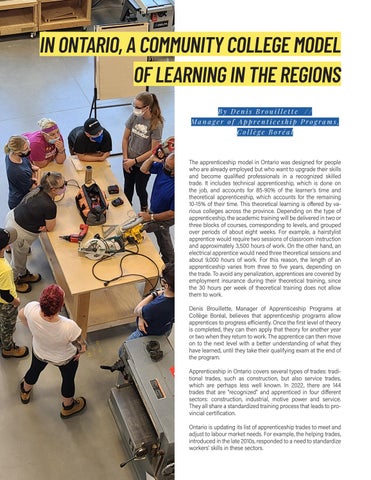32
Workforce training
IN ONTARIO, A COMMUNITY COLLEGE MODEL OF LEARNING IN THE REGIONS By Denis Brouillette
//
Manager of Apprenticeship Programs, Collège Boréal
The apprenticeship model in Ontario was designed for people who are already employed but who want to upgrade their skills and become qualified professionals in a recognized skilled trade. It includes technical apprenticeship, which is done on the job, and accounts for 85-90% of the learner’s time and theoretical apprenticeship, which accounts for the remaining 10-15% of their time. This theoretical learning is offered by va rious colleges across the province. Depending on the type of apprenticeship, the academic training will be delivered in two or three blocks of courses, corresponding to levels, and grouped over periods of about eight weeks. For example, a hairstylist apprentice would require two sessions of classroom instruction and approximately 3,500 hours of work. On the other hand, an electrical apprentice would need three theoretical sessions and about 9,000 hours of work. For this reason, the length of an apprenticeship varies from three to five years, depending on the trade. To avoid any penalization, apprentices are covered by employment insurance during their theoretical training, since the 30 hours per week of theoretical training does not allow them to work. Denis Brouillette, Manager of Apprenticeship Programs at Collège Boréal, believes that apprenticeship programs allow apprentices to progress efficiently. Once the first level of theory is completed, they can then apply that theory for another year or two when they return to work. The apprentice can then move on to the next level with a better understanding of what they have learned, until they take their qualifying exam at the end of the program. Apprenticeship in Ontario covers several types of trades: tradi tional trades, such as construction, but also service trades, which are perhaps less well known. In 2022, there are 144 trades that are "recognized" and apprenticed in four different sectors: construction, industrial, motive power and service. They all share a standardized training process that leads to provincial certification. Ontario is updating its list of apprenticeship trades to meet and adjust to labour market needs. For example, the helping trades, introduced in the late 2010s, responded to a need to standardize workers’ skills in these sectors.





